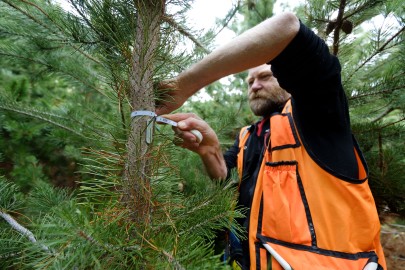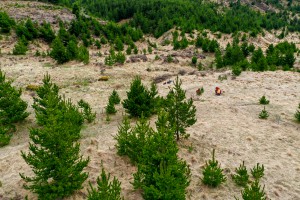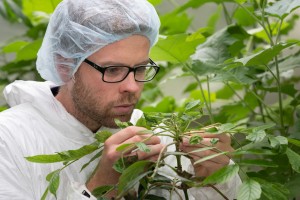Manaaki Whenua Principal Researcher in Ecosystem Ecology Dr Duane Peltzer says an intimate understanding of weed biology and ecology sets the stage for future weed research. “Providing useful information for weed management means understanding the causes and consequences of weed invasion, and an essential component of this is understanding weed impacts,” he says.
Directly measuring the impacts of the approximately 1,800 naturalised plant species in Aotearoa New Zealand is prohibitive, so Manaaki Whenua researchers have explored using trait-based approaches as a better way to predict which weeds are likely to have greater ecosystem effects. For example, how do the functional traits of invaders compare to those of native species, and can co-invasions or interactions among species amplify or dampen weed effects?
The first step was to complete an inventory of the Aotearoa New Zealand native and naturalised flora to highlight the overall distinctions between naturalised versus native plants in taxonomy, growth form, life history, and leaf traits, as an estimate of the vast potential of the naturalised flora to affect our native ecosystems.
“This inventory filled a key gap in fundamental data needed to inform decision-making and suggests the focus of further research,” says Senior Researcher Dr Angela Brandt. “It informed the Parliamentary Commissioner for the Environment’s 2021 Space Invaders report.”
Manaaki Whenua researchers also teamed up with collaborators from Australia, Singapore, and the US to propose a trait-based framework to evaluate potential mechanisms for the environmental impacts of co-occurring weeds that could be different from when those weeds occur alone.
“Interactions between invaders may be positive or negative, potentially amplifying or dampening an invader’s impacts on communities and ecosystems,” Angela says. “Selecting individual species for management could result in no biodiversity gains from weed control, or even produce unintended consequences such as competitive release of a subordinate, and possibly worse, weed.”
This work suggests some key ways in which future research can best support management decisions, including partnering with managers conducting weed removal activities to test approaches for different weed combinations. One possible approach is to target multiple weed species simultaneously, as was done when collectively releasing biocontrol agents for three invasive vines in the Cook Islands (see Natural enemies take charge in weed biocontrol and Weed busting success in Rarotonga).

Measuring the girth of wilding pines. Image: Brad White.
Wilding conifers provide an exemplar for developing more integrated, evidence-based management. The ‘Winning Against Wildings’ programme funded by the Ministry of Business, Innovation and Employment (MBIE), which ran from 2016 to 2021, gathered primary data on spread risk and impacts on biodiversity, developed new control tools, and integrated this knowledge through spatial forecast and social-ecological approaches.
The research showed that without management, invasion proceeds by about 5% per year but control costs increase by around 30% per year. “This was flagged as a concern, because wilding conifer reinvasion in places that have been managed was identified by landowners and managers as a major issue,” Duane explains.
“This issue is poised to explode because national funding has gone from a high of $33 million in 2022/23 to a new base of $10 million per year in 2023/24, with no new investment case likely for the next 2 years.”
Manaaki Whenua is involved in a current MBIE Endeavour programme led by Scion (‘Vive la Resistance’) to tackle this challenge. These research programmes on wilding conifers have been successful in planning and prioritising national and regional decision-making due to Manaaki Whenua’s major collaborative efforts across research institutions (including Scion, Lincoln University, and the University of Canterbury), coupled with research partnerships through the National Wilding Conifer Control Programme (NWCCP) and the Wilding Pine Network.
The structure of the NWCCP provided a valuable implementation pathway for outputs from these research programmes and is viewed as a success across government. But there is no equivalent programme or collective for the hundreds of other weeds being managed across Aotearoa New Zealand, and learning from this model could be essential as the threats from weeds worsen with climate and other global changes.
Weed effects often take a long time to manifest, so threats from weeds and the need to control them are often seen as less urgent than other issues, such as extreme weather events and pest animals. However, it’s much more cost-effective and environmentally sustainable to control weeds before they become widespread; for example, the benefit-to-cost ratio is 38:1 for wilding conifer management.
“Our goal is to fill evidence gaps and support decision-making needs for weed management that occurs earlier on the invasion curve, which would support uptake of the Parliamentary Commissioner for the Environment’s recommendations for tackling emerging weeds. An integral part of this is becoming better Te Tiriti partners in biosecurity and ensuring social licence for weed management decisions,” says Angela.
“Our focus for future work is how can we help effect a shift to more proactive weed management across the biosecurity system.”




